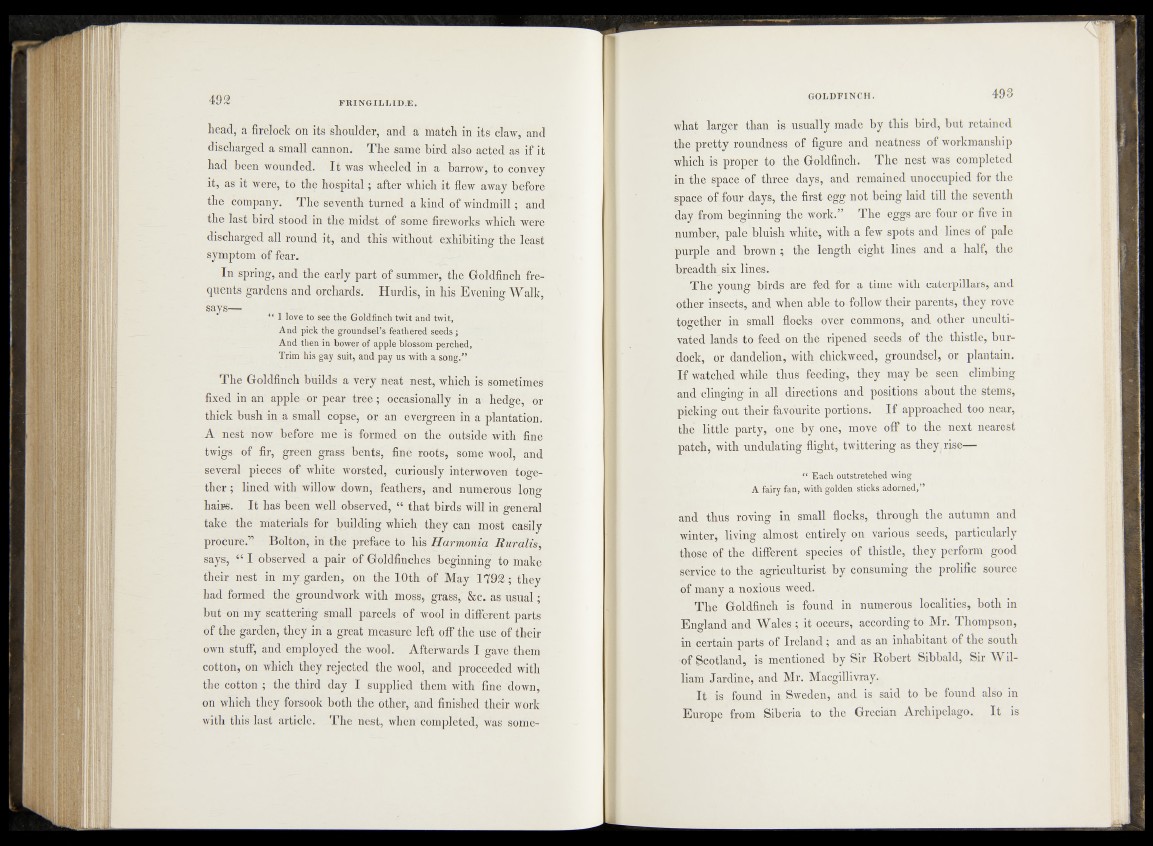
head, a firelock on its shoulder, and a match in its claw, and
discharged a small cannon. The same bird also acted as if it
had been wounded. It was wheeled in a barrow, to convey
it, as it were, to the hospital; after which it flew away before
the company. The seventh turned a kind of windmill; and
the last bird stood in the midst of some fireworks which were
discharged all round it, and this without exhibiting the least
symptom of fear.
In spring, and the early part of summer, the Goldfinch frequents
gardens and orchards. Hurdis, in his Evening Walk,
says—
“ 1 love to see the Goldfinch twit and twit,
And pick the groundsel’s feathered seeds;
And then in bower of apple blossom perched,
Trim his gay suit, and pay us with a song.”
The Goldfinch builds a very neat nest, which is sometimes
fixed in an apple or pear tree; occasionally in a hedge, or
thick bush in a small copse, or an evergreen in a plantation.
A nest now before me is formed on the outside with fine
twigs of fir, green grass bents, fine roots, some wool, and
several pieces of white worsted, curiously interwoven together
; lined with willow down, feathers, and numerous long
hairs. It has been well observed, “ that birds will in general
take the materials for building which they can most easily
procure.” Bolton, in the preface to his Harmonia Ruralis,
says, “ I observed a pair of Goldfinches beginning to make
their nest in my garden, on the 10th of May 1792; they
had formed the groundwork with moss, grass, &c. as usual;
but on my scattering small parcels of wool in different parts
of the garden, they in a great measure left off the use of their
own stuff, and employed the wool. Afterwards I gave them
cotton, on which they rejected the wool, and proceeded with
the cotton ; the third day I supplied them with fine down,
on which they forsook both the other, and finished their work
with this last article. The nest, when completed, was somewhat
larger than is usually made by this bird, but retained
the pretty roundness of figure and neatness of workmanship
which is proper to the Goldfinch. The nest was completed
in the space of three days, and remained unoccupied for the
space of four days, the first egg not being laid till the seventh
day from beginning the work.” The eggs are four or five in
number, pale bluish white, with a few spots and lines of pale
purple and brown ; the length eight lines and a half, the
breadth six lines.
The young birds are fed for a time with caterpillars, and
other insects, and when able to follow their parents, they rove
together in small flocks over commons, and other uncultivated
lands to feed on the ripened seeds of the thistle, burdock,
or dandelion, with chickweed, groundsel, or plantain.
If watched while thus feeding, they may be seen climbing
and clinging in all directions and positions about the stems,
picking out their favourite portions. If approached too near,
the little party, one by one, move off to the next nearest
patch, with undulating flight, twittering as they rise—
“ Each outstretched wing
A fairy fan, with golden sticks adorned,”
and thus roving in small flocks, through the autumn and
winter, living almost entirely on various seeds, particularly
those of the different species of thistle, they perform good
service to the agriculturist by consuming the prolific source
of many a noxious weed.
The Goldfinch is found in numerous localities, both in
England and "Wales ; it occurs, according to Mr. Thompson,
in certain parts of Ireland; and as an inhabitant of the south
of Scotland, is mentioned by Sir Robert Sibbald, Sir William
Jardine, and Mr. Macgillivray.
It is found in Sweden, and is said to be found also in
Europe from Siberia to the Grecian Archipelago. I t is